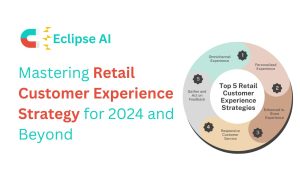
Crafting a Winning Customer Experience Strategy
Learn how to craft a winning customer experience strategy with our comprehensive guide. Discover best practices, real-life success stories, and key metrics to measure your CX initiatives.
Customers engage with brands through a myriad of touchpoints, from social media and online shopping to in-store visits and customer service calls. This fragmentation of customer journeys makes delivering a cohesive brand experience more challenging yet increasingly crucial. An effective omnichannel strategy emerges as a pivotal solution to this challenge, aiming to integrate various channels to offer a seamless and unified customer experience. Here’s a deep dive into understanding and implementing an omnichannel approach to foster enduring customer loyalty.
We see our customers as invited guests to a party, and we are the hosts. It’s our job every day to make every important aspect of the customer experience a little bit better
Jeff Bezos
An omnichannel strategy connects the dots between multiple channels—whether it’s your website, social media platforms, physical stores, or customer service lines—to deliver a consistent experience that mirrors your brand’s ethos at every touchpoint. This strategy is rooted in the understanding that customer interactions are no longer linear but are instead a complex web of touchpoints across different channels.
Statistics from a study by the Aberdeen Group highlight that companies with strong omnichannel customer engagement strategies retain an average of 89% of their customers, compared to a 33% retention rate for those with weak omnichannel efforts. This stark difference underscores the critical role of an integrated approach in driving customer loyalty.
Begin by mapping out the customer journey, from initial awareness through to purchase and beyond. This mapping should cover all potential interactions across digital and physical channels. Understanding these pathways is vital to pinpointing opportunities for seamless integration and identifying any gaps that may disrupt the customer experience.
Integrating your channels so that they communicate and share data seamlessly is crucial. For example, a customer’s online shopping cart should be accessible and editable through the mobile app, and in-store staff should be able to view a customer’s online purchase history to provide personalized assistance. This level of integration requires robust backend technology and a commitment to maintaining a unified customer database.
With 80% of shoppers more likely to buy from a company that offers personalized experiences (as reported by Epsilon), tailoring interactions across all channels can significantly impact loyalty. Use data analytics to understand customer preferences and behaviors, allowing for targeted marketing messages, product recommendations, and personalized shopping experiences.
A unified brand voice and messaging across all channels reinforce brand recognition and trust. Whether it’s the tone of voice in your emails, the aesthetic of your social media posts, or the customer service language, consistency is key to reinforcing your brand identity and values.
Technological solutions like CRM systems, AI chatbots, and machine learning algorithms can automate personalized interactions and predict future customer behaviors based on past interactions. For instance, AI can offer personalized product recommendations on your website or provide automated customer service responses that are consistent with your brand’s voice.
Your team should be well-versed in the nuances of your omnichannel strategy. This includes not only customer-facing roles but also behind-the-scenes staff who manage online content, social media, and data analysis. Training should emphasize the importance of a unified brand experience and provide the skills necessary to deliver it.
Actively seek out and listen to customer feedback across all channels. This feedback is invaluable for tweaking your strategy and ensuring that your omnichannel approach evolves with your customers’ needs. Regularly reviewing customer feedback and engagement data allows for continuous refinement of your strategy.
Adopting an omnichannel strategy is not just about bridging the gap between online and offline experiences; it’s about fundamentally rethinking how to engage with customers in a manner that fosters loyalty and trust. Here’s how a well-executed omnichannel approach can significantly elevate customer loyalty:
Customers value convenience and flexibility. An omnichannel approach meets these expectations by allowing customers to interact with a brand through multiple channels seamlessly. For example, the ability to research a product on a mobile app, ask questions via a live chat on a website, and then make a purchase in-store without any friction is a hallmark of omnichannel success. This seamless experience leads to higher customer satisfaction, which is a cornerstone of loyalty.
One of the most significant advantages of an omnichannel strategy is the capacity for deep personalization. By integrating data across touchpoints, brands can gain a holistic view of each customer’s preferences, behaviors, and interactions. This data enables companies to tailor communications, offers, and experiences directly to individual customers, making them feel valued and understood. Personalized experiences are proven to enhance customer loyalty; a study by Segment found that 44% of consumers say they will likely become repeat buyers after a personalized shopping experience with a company.
Consistency across channels reinforces brand reliability and trustworthiness, which are vital for customer loyalty. An omnichannel approach ensures that the brand message, tone, and values are uniform, regardless of how or where a customer interacts with the brand. This consistency helps build a strong brand image in the minds of customers, making them more likely to stay loyal.
An omnichannel strategy provides numerous opportunities for customer engagement, from social media interactions and mobile notifications to in-store experiences and online communities. Engaging customers across multiple channels keeps the brand top-of-mind and builds a deeper emotional connection, encouraging repeat purchases and long-term loyalty.
Effective customer support across all channels is crucial for retaining customers. Omnichannel support ensures that customers can receive help through their preferred method of communication, whether it’s a phone call, email, chatbot, or social media message. Quick and efficient resolution of issues contributes to a positive customer experience, reducing churn and increasing loyalty.
An omnichannel approach generates a wealth of data on customer preferences, behaviors, and feedback across different channels. This data can be analyzed to identify trends, anticipate customer needs, and continually refine the customer experience. By adapting to customer feedback and evolving preferences, businesses can stay relevant and maintain a loyal customer base.
The journey to implementing a successful omnichannel strategy requires dedication, strategic planning, and continuous adaptation. However, the rewards in terms of customer loyalty and business growth are substantial. In the competitive landscape of digital commerce, an omnichannel approach is not just advantageous—it’s essential for connecting with customers in a meaningful way and building lasting relationships.
As we navigate the complexities of modern retail and service industries, remember: the heart of omnichannel is not in the technology itself but in how it’s used to enrich and personalize the customer experience. In doing so, businesses not only foster loyalty but also set the stage for a dynamic and resilient future.
What empowers businesses to achieve such a nuanced understanding and engagement? The answer is in leveraging CX metrics to decode the customer journey, transforming raw data into actionable insights.
Eclipse AI assists companies in tracking and optimizing their customer experience metrics:

Learn how to craft a winning customer experience strategy with our comprehensive guide. Discover best practices, real-life success stories, and key metrics to measure your CX initiatives.

Uncover the secrets of your customers’ hearts! This guide explores the power of Voice of Customer Programs and shows you how to leverage them for growth and success.

In the bustling streets of retail, where every store and online platform is vying for attention, there’s a story of a little shop that transformed its fate by mastering the art of retail customer experience. This isn’t just any story; it’s a beacon for all of us in the marketing, customer experience, and product departments of retail businesses. It’s a story that reveals the heart of why retail customer experience is not just important but crucial in 2024 and beyond.
Don’t Let Your Competitors Understand Your Customers Better Than You
Don’t miss out. Try our 30-day Free Professional Trial.
